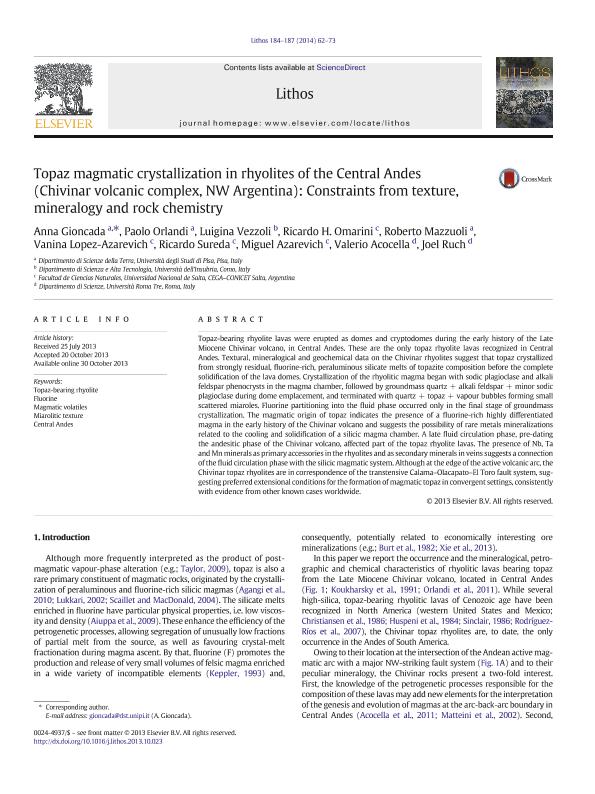Artículo
Topaz magmatic crystallization in rhyolites of the Central Andes (Chivinar volcanic complex, NW Argentina): Constraints from texture, mineralogy and rock chemistry
Gioncada, Anna; Orlandi, Paolo; Vezzoli, Luigina; Omarini, Ricardo Hector ; Mazzuoli, Roberto; Lopez Azarevich, Vanina; Sureda, Ricardo Jose
; Mazzuoli, Roberto; Lopez Azarevich, Vanina; Sureda, Ricardo Jose ; Azarevich, Miguel Basilio
; Azarevich, Miguel Basilio ; Acocella, Valerio; Ruch, Joel
; Acocella, Valerio; Ruch, Joel
 ; Mazzuoli, Roberto; Lopez Azarevich, Vanina; Sureda, Ricardo Jose
; Mazzuoli, Roberto; Lopez Azarevich, Vanina; Sureda, Ricardo Jose ; Azarevich, Miguel Basilio
; Azarevich, Miguel Basilio ; Acocella, Valerio; Ruch, Joel
; Acocella, Valerio; Ruch, Joel
Fecha de publicación:
10/2013
Editorial:
Elsevier Science
Revista:
Lithos
ISSN:
0024-4937
Idioma:
Inglés
Tipo de recurso:
Artículo publicado
Clasificación temática:
Resumen
Topaz-bearing rhyolite lavas were erupted as domes and cryptodomes during the early history of the Late Miocene Chivinar volcano, in Central Andes. These are the only topaz rhyolite lavas recognized in Central Andes. Textural, mineralogical and geochemical data on the Chivinar rhyolites suggest that topaz crystallized from strongly residual, fluorine-rich, peraluminous silicate melts of topazite composition before the complete solidification of the lava domes. Crystallization of the rhyolitic magma began with sodic plagioclase and alkali feldspar phenocrysts in the magma chamber, followed by groundmass quartz + alkali feldspar + minor sodic plagioclase during dome emplacement, and terminated with quartz + topaz + vapour bubbles forming small scattered miaroles. Fluorine partitioning into the fluid phase occurred only in the final stage of groundmass crystallization. The magmatic origin of topaz indicates the presence of a fluorine-rich highly differentiated magma in the early history of the Chivinar volcano and suggests the possibility of rare metals mineralizations related to the cooling and solidification of a silicic magma chamber. A late fluid circulation phase, pre-dating the andesitic phase of the Chivinar volcano, affected part of the topaz rhyolite lavas. The presence of Nb, Ta and Mn minerals as primary accessories in the rhyolites and as secondary minerals in veins suggests a connection of the fluid circulation phase with the silicic magmatic system. Although at the edge of the active volcanic arc, the Chivinar topaz rhyolites are in correspondence of the transtensive Calama–Olacapato–El Toro fault system, suggesting preferred extensional conditions for the formation of magmatic topaz in convergent settings, consistently with evidence from other known cases worldwide.
Palabras clave:
Topaz-Bearing Rhyolite
,
Fluorine
,
Magmatic Volatiles
,
Miarolitic Texture
Archivos asociados
Licencia
Identificadores
Colecciones
Articulos(CCT - NOA SUR)
Articulos de CTRO.CIENTIFICO TECNOL.CONICET - NOA SUR
Articulos de CTRO.CIENTIFICO TECNOL.CONICET - NOA SUR
Articulos(CCT - SALTA-JUJUY)
Articulos de CTRO.CIENTIFICO TECNOL.CONICET - SALTA-JUJUY
Articulos de CTRO.CIENTIFICO TECNOL.CONICET - SALTA-JUJUY
Articulos(INSUGEO)
Articulos de INST.SUP.DE CORRELACION GEOLOGICA
Articulos de INST.SUP.DE CORRELACION GEOLOGICA
Citación
Ruch, Joel; Acocella, Valerio; Azarevich, Miguel Basilio; Sureda, Ricardo Jose; Lopez Azarevich, Vanina; Mazzuoli, Roberto; et al.; Topaz magmatic crystallization in rhyolites of the Central Andes (Chivinar volcanic complex, NW Argentina): Constraints from texture, mineralogy and rock chemistry; Elsevier Science; Lithos; 184-187; 10-2013; 62-73
Compartir
Altmétricas



